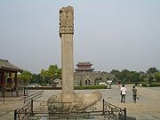
Fengtai District
Encyclopedia
Fengtai District is a suburban district of the municipality of Beijing
. It lies to the southwest of the urban core of the city.
 In Qing Dynasty
In Qing Dynasty
times, Fengtai was where the Imperial Manchu Army had its camps, trained, and held parades on festive occasions.
It is 304.2 square kilometers in area, making it the third-largest precinct in the greater urban part of Beijing, and is home to 790,000 inhabitants.
It is divided into 14 subdistricts of the city proper of Beijing, 2 towns, and 5 townships (2 of which are suburbs of the city proper of Beijing). This precinct is newly urbanized in comparison to those precincts in the old city, and until mid-1980s, it was still a mostly rural area where pig pens and goat pens were common, and major parts of the precinct had no electricity. It was only during the recent rapid economic development that the precinct was urbanized. Its postal code is 100071.
Changxindian (population 78,092) and Yungang (population 32,894) street committees of Beijing make up an urban area distinct from Beijing.
The district is mainly an industrial area (there are Beijing county level development zones including Fengtai Baipengyao Industrial Warehousing Area, Fengtai Changxindian Industrial Area, Fengtai materials Transport Area), but there are several cultural and historical sites such as the China Space Museum, Fengtai Park, and the Marco Polo Bridge
(Lugou Bridge).
(Jingzhu Expressway
).
Beijing
Beijing , also known as Peking , is the capital of the People's Republic of China and one of the most populous cities in the world, with a population of 19,612,368 as of 2010. The city is the country's political, cultural, and educational center, and home to the headquarters for most of China's...
. It lies to the southwest of the urban core of the city.
History

Qing Dynasty
The Qing Dynasty was the last dynasty of China, ruling from 1644 to 1912 with a brief, abortive restoration in 1917. It was preceded by the Ming Dynasty and followed by the Republic of China....
times, Fengtai was where the Imperial Manchu Army had its camps, trained, and held parades on festive occasions.
It is 304.2 square kilometers in area, making it the third-largest precinct in the greater urban part of Beijing, and is home to 790,000 inhabitants.
It is divided into 14 subdistricts of the city proper of Beijing, 2 towns, and 5 townships (2 of which are suburbs of the city proper of Beijing). This precinct is newly urbanized in comparison to those precincts in the old city, and until mid-1980s, it was still a mostly rural area where pig pens and goat pens were common, and major parts of the precinct had no electricity. It was only during the recent rapid economic development that the precinct was urbanized. Its postal code is 100071.
Changxindian (population 78,092) and Yungang (population 32,894) street committees of Beijing make up an urban area distinct from Beijing.
The district is mainly an industrial area (there are Beijing county level development zones including Fengtai Baipengyao Industrial Warehousing Area, Fengtai Changxindian Industrial Area, Fengtai materials Transport Area), but there are several cultural and historical sites such as the China Space Museum, Fengtai Park, and the Marco Polo Bridge
Lugou Bridge
The Lugou Bridge , also known as the Marco Polo Bridge in English, is a famous stone bridge located 15 km southwest of the Beijing city center across the Yongding River—a main tributary of Hai River The Lugou Bridge (Simplified: 卢沟桥; Traditional: 盧溝橋; Pinyin: Lúgōu Qiáo), also known as...
(Lugou Bridge).
Transportation
The southwestern stretches of the 3rd Ring Road, 4th Ring Road and 5th Ring Road all run through the area, as well as the Jingshi ExpresswayJingshi Expressway
The Jingshi Expressway is an expressway in China which links Beijing to the Shijiazhuang. It is c. 270 km in length. Its road numbering is G030...
(Jingzhu Expressway
Jingzhu Expressway
The Jingzhu Expressway is the first completed north-south expressway in the People's Republic of China, starting from Beijing and ending in Zhuhai, on the border with the Macau SAR....
).
Tourism
- Beijing World ParkBeijing World ParkBeijing World Park is a theme park that attempts to give visitors the chance to see the world without having to leave Beijing. The park covers 46.7 hectares and is located in the southwestern Fengtai District of Beijing. It is about 17 km from Tiananmen, the City center, and 40 km from...
- White Cloud TempleWhite Cloud TempleThe White Cloud Temple or the Monastery of the White Clouds is a Daoist temple located in Beijing, China. It is one of "The Three Great Ancestral Courts" of the Complete Perfection School of Taoism, and is titled "The First Temple under Heaven"....
- Marco Polo BridgeLugou BridgeThe Lugou Bridge , also known as the Marco Polo Bridge in English, is a famous stone bridge located 15 km southwest of the Beijing city center across the Yongding River—a main tributary of Hai River The Lugou Bridge (Simplified: 卢沟桥; Traditional: 盧溝橋; Pinyin: Lúgōu Qiáo), also known as...
- Wanping Castle (宛平城)
General references
- Harper, Damian, Beijing: City Guide, 7th Edition, Oakland, California: Lonely Planet Publications, 2007. Cf. pp. 96–98, 138, 266-267.
- Harper, Damian, Beijing: City Guide, 6th Edition, Oakland, California : Lonely Planet Publications, 2005. ISBN 1740597826. Cf. section beginning on p. 88, "Fengtai & Xuanwu".

